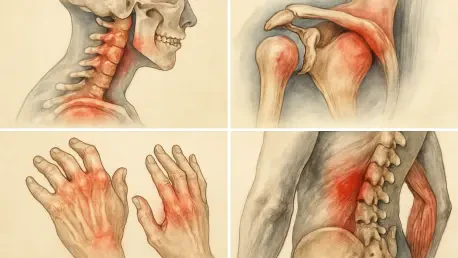The landscape of healthcare for rare musculoskeletal disorders is on the cusp of a remarkable transformation over the next decade, as groundbreaking therapies and heightened awareness begin to address the profound challenges faced by patients with conditions such as Duchenne Muscular Dystrophy (DMD), Spinal Muscular Atrophy (SMA), and Myasthenia Gravis. These disorders, though affecting a small segment of the population, impose a severe burden on quality of life, often leaving patients and families grappling with limited treatment options and unmet medical needs. Current projections indicate that the market for treatments targeting these conditions is set to grow substantially, expanding from USD 3.8 billion in 2025 to an impressive USD 8.9 billion by 2035, driven by a robust compound annual growth rate (CAGR) of 8.9%. This growth signals not only an increase in market value but also a shift in how these debilitating conditions are managed, with innovation paving the way for hope and improved outcomes.
At the heart of this evolution lies the promise of advanced therapeutic approaches, particularly gene therapy, which is redefining the possibilities for treating genetic disorders at their root. The forecast period from 2025 to 2035 is expected to witness a transition from traditional symptom management to precision medicine, reflecting broader trends in healthcare toward individualized solutions. This outlook delves into the key drivers, regional dynamics, competitive forces, and emerging trends shaping the market, offering a comprehensive view of how the industry is poised to evolve. As therapies become more accessible and integrated into global healthcare systems, the potential to transform lives grows, setting the stage for a decade of significant progress.
Market Growth and Projections
Growth Trajectory and Key Drivers
The market for treatments addressing rare musculoskeletal disorders is charting an ambitious path, projected to rise from USD 3.8 billion in 2025 to USD 8.9 billion by 2035, reflecting a steady CAGR of 8.9%. This substantial growth is underpinned by several critical factors, including the rapid adoption of cutting-edge therapeutic modalities that promise to tackle these conditions more effectively than ever before. Among these, advancements in medical technology stand out as a primary catalyst, enabling the development of solutions that target the underlying causes of disorders rather than merely alleviating symptoms. Additionally, heightened public and professional awareness of rare diseases is fueling demand, as advocacy efforts shine a spotlight on previously overlooked conditions, prompting both public and private sectors to prioritize solutions.
Another significant driver of this market expansion is the surge in research investments, particularly in developed regions where funding for medical innovation is robust. Governments, academic institutions, and private enterprises are channeling resources into the discovery and refinement of novel treatments, ensuring a steady pipeline of options for patients. This financial backing is complemented by a growing emphasis on healthcare specialization, where dedicated facilities and expertise are increasingly available to manage complex cases. Together, these elements create a fertile environment for market growth, positioning the sector to address long-standing gaps in care while improving patient outcomes on a global scale.
Phased Expansion: 2025-2030 and 2030-2035
The trajectory of market growth over the next decade is expected to unfold in two distinct phases, each with its own focus and contributions to the overall expansion. From 2025 to 2030, the emphasis will be on therapeutic innovation, as new treatments, particularly those involving advanced genetic approaches, gain traction in clinical settings. During this initial phase, the market is projected to add USD 1.9 billion in value, representing 37% of the total growth anticipated by 2035. A key aspect of this period will be the reduction in costs associated with novel therapies, driven by technological advancements and economies of scale, which will enhance accessibility for a broader patient base and lay the groundwork for wider adoption.
The subsequent phase, spanning 2030 to 2035, will shift the focus toward integration and large-scale deployment of these therapies into comprehensive healthcare frameworks. This period is expected to account for 63% of the market’s growth, contributing USD 3.2 billion as treatments become seamlessly embedded in specialty care platforms and broader medical systems. Efforts during these years will center on optimizing delivery mechanisms and ensuring that advanced therapies are accessible across diverse regions and healthcare settings. This phased progression highlights the evolving nature of the industry, moving from pioneering breakthroughs to systemic incorporation, ultimately aiming to maximize clinical impact and patient benefit worldwide.
Therapeutic Innovations and Market Segmentation
Dominance of Gene Therapy
Gene therapy has emerged as the cornerstone of modern treatment strategies for rare musculoskeletal disorders, commanding a significant 35% share of the market due to its unparalleled precision and potential for long-term efficacy. Unlike traditional approaches that often focus on managing symptoms, this modality targets the genetic underpinnings of conditions like DMD and SMA, offering transformative outcomes for patients who previously faced limited options. Its prominence is bolstered by continuous advancements in genetic targeting and delivery mechanisms, which enhance safety profiles and clinical results. As a result, gene therapy is setting new benchmarks for treatment standards, driving a fundamental shift in how these disorders are addressed across global healthcare systems.
The widespread adoption of gene therapy is further supported by its growing integration into specialty care environments, where expertise and infrastructure enable effective implementation. While it overshadows conventional methods such as enzyme replacement therapy and small molecule drugs, these older approaches still play a supplementary role in comprehensive care plans. The dominance of gene therapy also reflects a broader industry trend toward precision medicine, where treatments are tailored to individual genetic profiles, promising better outcomes. As research progresses, the potential for even more refined applications of this technology continues to expand, solidifying its position as the leading therapeutic option in this market over the forecast period.
Disease Focus and End-User Insights
Among the various rare musculoskeletal disorders, Duchenne Muscular Dystrophy stands out as a primary focus of treatment development, particularly in markets like Japan, where it accounts for 28.5% of demand. The severity of this condition, coupled with the availability of targeted therapies, has positioned it as a clinical priority, driving significant investment in research and therapeutic solutions. Other conditions, such as Spinal Muscular Atrophy and Myasthenia Gravis, also garner substantial attention, reflecting a diverse spectrum of needs within this niche sector. This segmentation by disease type underscores the complexity of the market, where clinical priorities are shaped by both prevalence and the feasibility of developing effective interventions for specific conditions.
Specialty hospitals, holding a commanding 50% market share as end-users, are pivotal in delivering these advanced treatments, leveraging their concentrated expertise and resources to manage rare disorders effectively. These institutions serve as hubs for innovation and care, often equipped with the latest technologies and staffed by specialists trained in niche medical areas. Beyond hospitals, research centers and rehabilitation facilities contribute to the ecosystem, focusing on therapeutic development and long-term patient management, respectively. This distribution of roles among end-users highlights the importance of a coordinated approach, where specialized infrastructure ensures that complex treatments are not only developed but also delivered in a manner that maximizes patient benefit across diverse settings.
Regional Dynamics and Growth Patterns
North America and Europe are at the forefront of market growth for rare musculoskeletal disorder treatments, driven by robust healthcare infrastructure and significant research funding. The United States, in particular, leads with a projected CAGR of 10.5%, reflecting its role as a global hub for therapeutic innovation and rapid adoption in clinical settings. This dominance is supported by extensive investment in medical technology and a high concentration of specialty care facilities, which facilitate the implementation of advanced treatments. Similarly, European nations like Germany, with a 10.1% CAGR, contribute significantly to the market’s expansion, though they face unique challenges related to diverse healthcare funding models and regulatory landscapes that vary across the region.
In contrast, the Asia-Pacific region is emerging as a promising frontier, with countries like Japan and South Korea demonstrating notable growth at CAGRs of 9.3% and 8.5%, respectively. These markets are undergoing rapid modernization of healthcare systems, coupled with increasing government support for rare disease initiatives, which is accelerating the adoption of cutting-edge therapies. While they lag behind North America and Europe in terms of current market maturity, their trajectory suggests a shift toward more equitable global access to advanced care. These regional variations highlight the influence of local policies, economic conditions, and technological readiness on the pace and nature of market development, shaping a diverse yet interconnected landscape over the forecast period.
Competitive Landscape and Industry Challenges
Key Players and Competitive Focus
The competitive environment for rare musculoskeletal disorder treatments is characterized by a moderate concentration, with 8-12 major players controlling 40-45% of the global market share. Established companies like Sarepta Therapeutics, Biogen, and Roche anchor the industry with their deep expertise and extensive global networks, providing stability and setting high standards for therapeutic quality. Their strength lies in comprehensive portfolios that cover a range of disorders, alongside established relationships with healthcare providers that create barriers to entry for smaller competitors. This dominance ensures a focus on reliability and proven clinical outcomes, which are critical in a market dealing with complex and rare conditions.
Innovation, however, is being driven by challengers such as PTC Therapeutics, Novartis, and BioMarin Pharmaceutical, which are carving out significant space through specialized technologies and rapid development cycles. These companies prioritize breakthrough treatments tailored to specific disease segments, appealing to healthcare providers seeking cutting-edge solutions. Unlike many industries, competition in this sector centers on clinical efficacy and integration with specialized care systems rather than price, reflecting a shared commitment to patient outcomes over cost-cutting. This dynamic fosters an environment where both stability and disruption coexist, pushing the boundaries of what is possible in rare disease care as new players and biotechnological advancements continue to emerge.
Barriers to Market Expansion
Despite the promising growth outlook, significant barriers threaten to impede the market’s expansion for rare musculoskeletal disorder treatments. High treatment costs remain a formidable challenge, often placing advanced therapies out of reach for patients in underfunded regions or those without adequate insurance coverage. This issue of affordability is compounded by limited accessibility, as specialized care facilities and expertise are not uniformly distributed globally, creating disparities in who can benefit from cutting-edge solutions. Addressing these economic hurdles will require innovative reimbursement models and public-private partnerships to ensure that financial constraints do not undermine the potential impact of therapeutic advancements.
Regulatory complexities add another layer of difficulty, with lengthy approval processes and stringent safety requirements often delaying the introduction of novel therapies to the market. These challenges vary by region, with stricter oversight in some areas like Europe potentially slowing progress compared to more streamlined systems elsewhere. Additionally, scalability concerns arise due to the inherently small patient populations associated with rare diseases, which clash with the high costs of research and development, raising questions about commercial viability. Overcoming these obstacles will necessitate policy reforms, international collaboration, and strategic investments to balance the need for innovation with the realities of market dynamics, ensuring that growth is sustainable over the long term.
Emerging Trends and Future Outlook
Shift Toward Precision Medicine
A defining trend in the market for rare musculoskeletal disorder treatments is the pronounced shift toward precision medicine, with gene therapy leading the charge as a transformative approach. Holding a 35% market share, this modality exemplifies the move away from one-size-fits-all solutions to treatments tailored to individual genetic profiles, offering unprecedented efficacy for conditions once deemed incurable. The ability to target the root causes of disorders like DMD and SMA marks a paradigm shift, supported by ongoing advancements in genetic engineering and delivery systems that enhance both safety and effectiveness. This trend aligns with broader healthcare priorities, positioning precision medicine as the future of rare disease management over the next decade.
The implications of this shift extend beyond clinical outcomes, influencing how treatments are developed, tested, and deployed in real-world settings. As precision medicine gains traction, it drives the need for specialized diagnostic tools and expertise, further emphasizing the role of dedicated healthcare infrastructure. Regulatory frameworks are also adapting to accommodate these innovations, though challenges remain in ensuring timely approvals without compromising safety. The focus on personalized care is reshaping industry standards, encouraging investment in research that prioritizes long-term benefits for patients. This movement promises to redefine therapeutic possibilities, offering hope to those affected by rare disorders as the market evolves through 2035.
Global Access and Specialization
While developed markets in North America and Europe lead the charge in therapeutic innovation, emerging economies, particularly in the Asia-Pacific region, are focusing on adoption and integration of advanced treatments. Countries like Japan and South Korea are witnessing rapid growth, driven by healthcare modernization and increasing governmental support for rare disease care initiatives. This trend signals a global push toward equitable access, as efforts to bridge the gap between mature and developing markets intensify. The disparity in current capabilities highlights the need for tailored strategies that account for regional differences in resources and infrastructure, ensuring that advancements benefit a wider population over time.
Healthcare specialization remains a critical factor in facilitating this global expansion, with specialty hospitals and research centers serving as essential hubs for delivering complex therapies. These institutions, commanding a 50% market share as end-users, are equipped to handle the intricacies of rare disease treatment, from initial diagnosis to long-term management. Their role underscores the importance of dedicated resources and trained professionals in achieving optimal outcomes, particularly as treatments become more sophisticated. As the market progresses toward 2035, the interplay between geographic expansion and specialized care will shape how effectively innovations are scaled, addressing both access and quality in the fight against rare musculoskeletal disorders.
Reflecting on Transformative Progress
Looking back over the decade-long journey from 2025 to 2035, the market for rare musculoskeletal disorder treatments revealed a story of remarkable progress, marked by a near tripling in value and a profound shift in therapeutic paradigms. Gene therapy solidified its place as a game-changer, while regional leaders in North America and Europe set benchmarks for innovation that inspired global adoption. The contributions of specialty care infrastructure proved indispensable, ensuring that complex treatments reached those in need.
As attention turned to the future, actionable steps emerged as priorities, including the development of innovative funding models to address cost barriers and the streamlining of regulatory processes to accelerate therapy approvals. Collaboration across borders also stood out as a vital strategy, fostering knowledge exchange and resource sharing to enhance access in emerging markets. These considerations, built on the foundation of past achievements, offered a roadmap for sustaining momentum, ensuring that the strides made in rare disease care continued to evolve, delivering lasting impact for patients worldwide.









